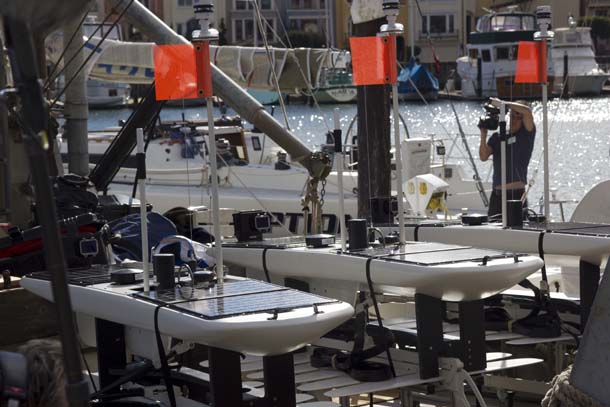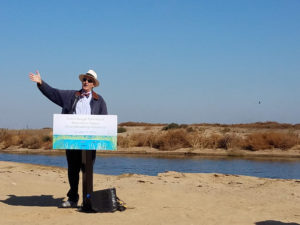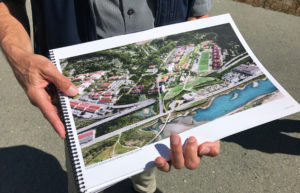The “wave gliders” will, if successful, traverse the longest distance of any unmanned ocean craft as they cross the Pacific Ocean. Driven entirely off wave power and solar panels, the gliders will remotely study the ocean and send data back to on-shore computers via satellite. Sensors on board are collecting data on everything from chlorophyll and dissolved oxygen levels to meteorological conditions.
Officials from the company in charge, Sunnyvale-based Liquid Robotics, said they hope this demonstration project proves that robots can open up what has become the “last frontier” on the planet – the ocean. Less than 5 percent of it has been explored.
“It really is a tough place to operate. That’s the reason this has not happened before,” said Liquid Robotics CEO Bill Vass, the former president and COO of Sun Microsystems Federal at the glider’s send-off party at the St. Francis Yacht Club at Crissy Field in San Francisco.
“It changes the way we collect data in the ocean and ways of operating in the ocean,” he added.
In the decades following the heyday of Jacques Cousteau, there has been no major development in techniques for ocean exploration. Vass said a new golden era is beginning because of advancements in micro-electronics and high performance computer processing, the miniaturization of GPS and satellite communication systems, and renewable energies.
-
The four wave gliders were named after famous explorers: Pap Mau (Pius Piailug), Benjamin (Franklin), Piccard Maru (Jacque Piccard), and Fontaine Maru (Matthew Fontaine). Photo by Alison Hawkes.
Part of what gives the wave glider such endurance is that it doesn’t need fossil fuels to operate. Instead, underwater wings that look like window blinds tilt the surface-sitting glider up and then down, propelling it forward. Solar panels on top of the glider power the sensors and communication system. The company hopes the gliders can be used to study hurricanes.
Scientists are excited about the possibilities for research. The usual method of collecting data on the oceans involves sending out moorings and boats, both of which require a lot of manpower.
“I want these things to replace me,” said Francisco Chavez, a climate change scientist at the Monterey Bay Aquarium Research Institute.
Chavez believes the robots could be useful in tracking moving objects, like whales or harmful algal blooms. The institute is in the process of augmenting one of the wave gliders with additional sensors that will aid its research projects, said Chavez. He’d like to outfit one of the gliders with a CO2 sensor so he can better track ocean acidification due to climate change.
The 300-day ocean voyage, which launched just south of the shipping channel into San Francisco Bay, will be entirely scientific in nature. In fact, all the data collected is publicly available for free and in near-real time.
But to Liquid Robotics, which raised $22 million in venture capital funding in June, all the publicity could also lead to some lucrative business prospects. The oil and gas industry is interested in using the gliders, as are the shipping and fishing industries. They cost $140,000 each for the hardware and upwards of $250,000 with all the sensors.
If the wave gliders become the next big thing in ocean exploration, will they ultimately become a tool for extracting more resources from the deep, blue sea?
Graham Hine, a Liquid Robotics senior vice president, argues that commercial uses can also be beneficial. The wave gliders could help ships stay in route, expending less fuel. BP has had four wave gliders in the Gulf of Mexico since August 2010 to monitor currents and hydrocarbon levels around the Deepwater Horizon wells.
“They want to quantify the impact of an event and limit ongoing liability,” Hine said.
The four gliders bobbing their way across the ocean right now are headed first to Hawaii, and then will break into pairs with one set to land in Australia and the other in Japan. A number of obstacles, like floating kelp patties or drift nets, could waylay them, or end their trip entirely.
Among the sightseeing highlights of the 33,000 nautical mile journey: the White Shark Cafe, the North Pacific Gyre, and the Mariana trench, the deepest part of the world’s oceans.
Bon voyage, wave gliders.

.jpg)





